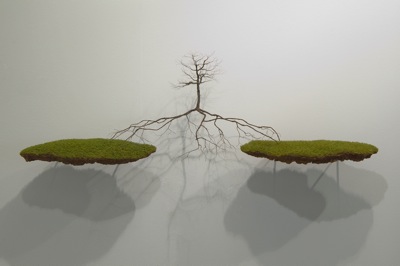
by Helen Shewry
On the posh side of London you’ll find the second and final instalment of a Pangaea – referring to a supercontinent existing 250 million years ago – where the Saatchi Gallery gathers emerging artists from Africa and Latin America. As the title suggests, these artists explore their places of origin, its history, complexities and transformations, using a variety of media and employing both traditional and contemporary methods.
The first room is very Saatchi, a massive and excessively bright, white space contains a neatly constructed rectangle of 97,000 semi-inflated and uninflated blue plastic bags. Jean-Françoise Boclé’s Everything Must Go! is there for the shock factor on entry to make us question our wastefulness and our environment in a consumerist culture. The installation is presented as a vast expanse of undulating blue to resemble the sea and is supposed to remind us of lives lost in the transatlantic slave trade. However, it seems for most that it’s just a good photo opportunity with the option to post on one of the many social media platforms to be glanced at then instantly dismissed.

Jean-François Boclé, Everything Must Go, 2014
97,000 blue plastic bags (HD polythlene, thickness 18/20 microns) 54 x 30 x 14 cm each
(c) Justin Piperger, 2015 Image courtesy of the Saatchi Gallery, London
As easily as you may disregard some of the art, all the work in this exhibition has a dark edge to it which you can’t sidestep. Ephrem Solomon’s woodcuts and mixed media work has a limited palette of black, white, brown and yellow. He uses newspaper to create a layered background of collage which is the inverse of his carvings, outlines and repeating patterns. Most of his woodcuts are portraits of Ethiopian people in simple dress with flip-flops. He displays the clarity and simplicity of everyday life while exposing pain and sadness with the grave expressions of the people depicted. His work also contains scattered chairs and flip-flops. All his marks and symbols allude to political and religious tensions which include the ever-changing landscape and with it the destruction and altering of communities and individual lives.
Some of the more delicate and beautiful works are by Cuban born Jorge Mayet. His focus on realistic landscapes and natural forms include trees from memories of his homeland. Suspended, dark finger-like roots are entangled and tied with electrical wires which cling to the tree roots like tiny gifts. A grey trunk grows out of these roots and leads up to the most fragile, pale ash branches with the sense it has been charred.
Mayet’s other piece, Entre Dos Aguas, is another spindly tree but this one has its roots reaching out, tentatively touching some lush grass. The tension he has created with the elongated tendrils just grazing the earth – its sustenance – echoes his longing for home. His work also comments on the changing political and social environment. Both his intricately crafted trees are thoughtful, sad and yet hopeful.

Jorge Mayet Entre Dos Aguas 2008
Electrical wire, paper, acrylics, fabric 33 x 100 x 20 cm(
c) Jorge Mayet Image courtesy of the Saatchi Gallery
The other art varies from brightly painted canvases and ceramics to carnivalesque faces and hacked off genitalia. Apart from the three artists I’ve mentioned there was little to keep me interested. I found it repetitive and although I don’t want to say shallow, because obviously the history and culture behind the artists and their homeland is far from shallow, it has the feel of the superficial. I don’t get the essence of the artists in their work, I feel as if they are trying too hard to show us something. I actually found the images and the bios of themselves more fascinating than their art. Because of the number of artists and the lack of information (unless purchased) it made this show difficult to understand fully. Each artist’s country and its political and social history, plus their own current viewpoint is open for exploration and discussion. For those who feel art should speak for itself – most of it was lacking.
I’m glad it’s a free exhibition but I was bored in an art gallery and I’m annoyed with Saatchi for making that so. Usually, even if the art isn’t for me, I can still learn from it and enjoy it in a different form, but here something is missing. If you would like to check it out and make up your own mind then you have until 6th September 2015.
Step into Slone Square and find Saatchi Gallery at Duke of York’s HQ, King’s Road, London SW3 4RY. Open 7 days a week 10 am – 6 pm.

Leave a Reply